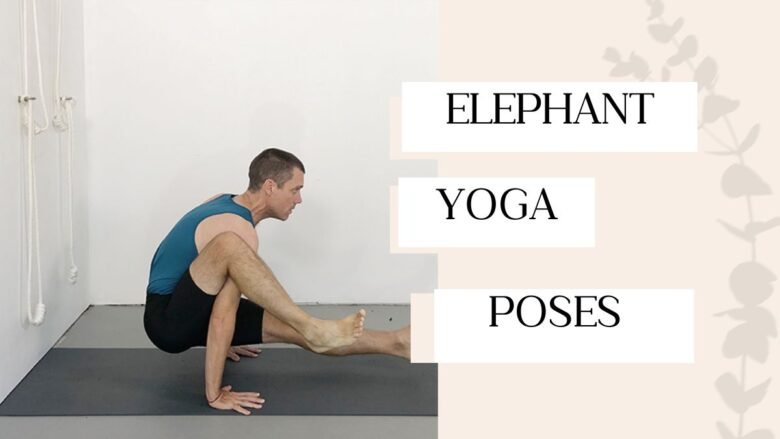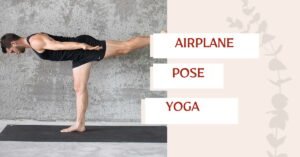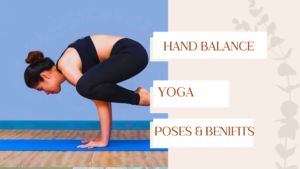🧘♀️ Welcome to the Aatmyogashala blog is this blog we will discuss about Elephant Pose Yoga.Elephant Pose, known in Sanskrit as “Hastināsana,” is a rejuvenating yoga posture that mimics an elephant’s movements 🐘. This pose enhances flexibility, strength, and balance.
By stretching the spine and opening the chest, 🧘♀️ it helps alleviate back pain and improve posture. It also activates core muscles and aids in emotional release, promoting a sense of grounding and calm 🌿. Suitable for all levels, Elephant Pose yoga is a great addition to any yoga sequence, offering both physical and mental benefits. 💪🧘♂️
How to Perform Elephant Pose Yoga
- Start in a Standing Position: Begin by standing with your feet hip-width apart and your arms relaxed by your sides. Ensure that your weight is evenly distributed across both feet.
- Inhale and Lift Your Arms: As you take a deep breath in, slowly raise your arms overhead with your palms facing each other. Feel the stretch along your sides and spine.
- Bend Forward: On your exhale, gently bend at the hips and lower your torso towards the ground. Allow your arms to dangle down, mimicking the trunk of an elephant.
- Swing Your Arms: With your torso parallel to the floor, begin to gently sway your arms from side to side like an elephant’s trunk. Keep your neck relaxed and your gaze downward.
- Activate Your Core: While swinging, engage your core muscles to support your lower back. Maintain a slight bend in your knees to avoid hyperextension.
- Hold the Pose: Continue swinging your arms for several breaths, feeling the stretch in your spine and the activation of your core and leg muscles.
- Return to Standing: To come out of the pose, stop the swinging motion, take a deep breath in, and slowly lift your torso back to a standing position as you exhale. Lower your arms back to your sides.
- Relax and Breathe: Pause for a moment in a standing position to notice the sensations in your body and to allow your breath to return to its natural rhythm.
Benefits of Practicing Elephant Pose
Elephant Pose yoga offers a multitude of benefits for both the body and mind. Here are some key advantages of incorporating this pose into your yoga routine:
- Improves Flexibility: The gentle forward bend and swinging motion help to lengthen and stretch the spine, hamstrings, and shoulders, enhancing overall flexibility.
- Strengthens Core Muscles: By activating the core muscles during the pose, practitioners can build abdominal strength, which is crucial for maintaining balance and stability.
- Enhances Balance and Coordination: The dynamic movement of swaying the arms requires and improves balance and coordination, making you more aware of your body’s alignment and movements.
- Reduces Back Pain: The spinal stretch and core engagement can help alleviate tension and discomfort in the lower back, promoting better posture and spinal health.
- Promotes Relaxation: The rhythmic motion and focus on deep breathing during the pose encourage relaxation, reducing stress and anxiety levels.
- Stimulates Circulation: Swinging the arms helps to increase blood flow and stimulate circulation, which can aid in detoxification and improve overall energy levels.
- Grounds and Centers the Mind: The pose’s focus on mimicking the grounded nature of an elephant can help to center the mind and bring a sense of stability and calmness.
Improves Strength and Flexibility
Elephant Pose yoga is highly effective in enhancing both strength and flexibility. The pose’s dynamic nature requires active engagement of the core muscles, which helps build abdominal strength essential for maintaining proper posture and stability.
Additionally, the gentle forward bend and swaying motion provide a comprehensive stretch to the spine, shoulders, and hamstrings, significantly improving overall flexibility.
By regularly practicing Elephant Pose, practitioners can develop a strong and supple body, reducing the risk of injuries and enhancing their performance in various physical activities.
The harmonious blend of strength and flexibility cultivated through this pose supports a balanced and healthy body, making it a valuable addition to any yoga practice.
Relieves Stress and Anxiety
Elephant Pose yoga is particularly effective in relieving stress and anxiety. The rhythmic motion of swaying the arms, combined with focused, deep breathing, creates a meditative rhythm that helps to quiet the mind and release accumulated tension.
As you swing your arms and engage in this gentle physical activity, your body begins to produce endorphins, which are natural mood lifters. Additionally, the grounding nature of Elephant Pose encourages mindfulness, allowing you to become more present and attuned to your body and breath.
This state of mindfulness can significantly reduce feelings of anxiety and promote a sense of calm and tranquility. Practicing Elephant Pose regularly can thus serve as a powerful tool for managing stress, fostering emotional resilience, and enhancing overall mental well-being.
Alleviates Back Pain
Elephant Pose yoga is particularly beneficial for alleviating back pain. The gentle forward bend involved in the pose provides a soothing stretch to the entire length of the spine, helping to release tension in the lower back and alleviate discomfort.
By engaging the core muscles, practitioners can support the lower back and maintain proper alignment, which reduces the strain often associated with prolonged sitting or poor posture.
Additionally, the rhythmic swaying motion of the arms promotes relaxation of the back muscles, encouraging them to loosen and release built-up tension.
Regular practice of Elephant Pose can enhance spinal mobility, improve posture, and provide much-needed relief for those suffering from chronic back pain.
Integrating this pose into your daily routine can be a natural and effective way to maintain a healthy spine and keep back pain at bay.
Modifications for Different Levels
Beginner Modifications
For those new to yoga or Elephant Pose, it’s important to start slowly and listen to your body. To ease into the pose, try the following modifications:
- Arm Swings with Lower Intensity: Initially, keep your arm swings more gentle and controlled. Focus on the motion without pushing for a wide range of movement.
- Support with a Chair: Place a chair in front of you and lightly hold on to the backrest for additional support and balance while swaying your arms.
- Shallow Forward Bend: Bend forward only as far as is comfortable for you. Maintain a slight bend in your knees to avoid straining your lower back.
- Shorter Hold Time: Limit the duration of the pose to a few breaths and gradually increase as you become more comfortable.
Intermediate Modifications
If you’re comfortable with the basic pose and looking to deepen your practice, consider these intermediate modifications:
- Increase the Swinging Range: Gradually increase the range and intensity of your arm swings, engaging your core more actively to support this movement.
- Deeper Forward Bend: Aim to deepen your forward bend by hinging more at the hips, while still keeping your spine elongated.
- Add a Twist: Incorporate a gentle twist into the pose by rotating your torso slightly to one side as you swing your arms, and then to the other side, enhancing spinal mobility.
- Longer Hold Time: Extend the duration of the pose, holding it for a greater number of breaths to enhance endurance and flexibility.
Advanced Modifications
For advanced practitioners seeking a more challenging variation, try these modifications:
- Weighted Arm Swings: Hold light weights or small dumbbells in your hands while swinging your arms to increase resistance and strengthen your shoulders and arms.
- Single-Leg Balance: Lift one leg slightly off the ground while performing the pose to challenge your balance and engage your core even further.
- Dynamic Flow: Transition smoothly between Elephant Pose yoga and other yoga poses like Forward Fold or Downward Facing Dog to create a dynamic flow that increases both flexibility and strength.
- Extended Hold with Breath Control: Incorporate advanced breath control techniques, such as Ujjayi breathing, while holding the pose for an extended period to deepen your practice and enhance concentration.
By customizing Elephant Pose yoga to suit different skill levels, individuals can safely enjoy the benefits of this versatile yoga posture, whether they are beginners, intermediate practitioners, or advanced yogis.
Precautions and Contraindications
While Elephant Pose yoga offers numerous benefits, it is important to practice it with caution, especially if you have certain medical conditions or physical limitations. Here are some key precautions and contraindications to consider:
- Lower Back Issues: If you have existing lower back pain or injuries, approach Elephant Pose yoga cautiously. Avoid deep forward bends and opt for more gentle movements to prevent exacerbating your condition. Always listen to your body and avoid any motion that causes discomfort.
- Shoulder Injuries: People with shoulder injuries or inflammation should avoid vigorous arm swings. A more controlled and gentle movement may be suitable, or it might be best to refrain from this aspect of the pose altogether until fully healed.
- Neck Problems: If you experience neck issues or have a history of neck injuries, ensure that your head and neck remain neutral and avoid any sudden or jerky movements that might cause strain.
- Pregnancy: Pregnant individuals should modify Elephant Pose yoga to avoid deep forward bending, which can place pressure on the abdomen. Consulting a qualified prenatal yoga instructor for appropriate modifications is advisable.
- Dizziness or Balance Issues: Those prone to dizziness or with balance problems should start with light swings and may consider using a chair for support to prevent falls. Avoid closing your eyes if it affects your balance.
- High Blood Pressure: If you have high blood pressure, practice Elephant Pose yoga with caution. Sudden movements or holding your breath can increase your blood pressure, so focus on slow, gentle motions and maintain smooth breathing throughout the practice.
By being mindful of these precautions and contraindications, you can safely incorporate Elephant Pose yoga into your yoga routine, ensuring a beneficial and enjoyable experience. Always consult with a healthcare professional or a certified yoga instructor if you have any concerns or specific health conditions before practicing this or any other yoga pose.
Also Read:Inversion Yoga Poses
Incorporating Elephant Pose into Your Yoga Routine
Incorporating Elephant Pose yoga into your yoga routine can bring a refreshing change and enhance the overall benefits of your practice. Begin by including it in your warm-up sequence, as its dynamic movements can help to gently wake up your muscles and increase blood flow.
Consider performing Elephant Pose right after breathing exercises or initial stretches to gradually build up your energy.
You can also use Elephant Pose yoga as a transitional movement. For instance, integrate it between standing poses such as Warrior II and Forward Fold, creating a fluid, mindful flow that keeps your practice engaging and balanced. This smooth transition will not only improve your flexibility but also your coordination and control.
For those looking to cool down, Elephant Pose yoga can be a gentle and relaxing way to wind down your session.
Pair it with deep, diaphragmatic breathing to promote relaxation and release any residual tension in your back and shoulders. Follow it up with restorative poses like Child’s Pose or Legs-Up-The-Wall to ensure a comprehensive cooldown.
Remember, consistency is key. Incorporating Elephant Pose yoga regularly, whether it’s daily or several times a week, can help you reap the full benefits over time and keep your practice varied and enjoyable.
Conclusion
Elephant Pose yoga is a versatile and accessible yoga posture that offers an array of physical and mental benefits. Whether you are a beginner or an advanced practitioner, you can adapt the pose to suit your individual needs and fitness level. By practicing Elephant Pose yoga regularly, you can enhance flexibility, improve posture, and increase overall body strength.
It also provides an excellent opportunity to cultivate mindfulness and focus, making it a valuable addition to any yoga routine. Remember to approach the pose with awareness and respect for your body’s limits, and always consult with a healthcare professional or certified yoga instructor if you have any health concerns. Embrace Elephant Pose yoga as a unique and enriching component of your practice, and experience the holistic benefits it brings to your well-being.
Frequently Asked Questions
1. What is the primary benefit of practicing Elephant Pose?
Elephant Pose yoga primarily helps to enhance flexibility, particularly in the spine and hamstrings, while also improving posture. It engages various muscle groups, promoting overall body strength and balance.
2. Can beginners practice the Pose?
Yes, beginners can practice Elephant Pose yoga by modifying the movements to suit their flexibility and strength levels. It is advisable to start with more gentle swings and gradually increase the range of motion as comfort and skill improve.
3. How often should I incorporate Elephant Pose into my routine?
The frequency of practicing Elephant Pose can vary based on individual goals and fitness levels. Generally, incorporating it into your routine 2-3 times a week can help you reap substantial benefits. Consistency is key to seeing improvements over time.
4. Are there any specific breathing techniques recommended during Elephant Pose?
Incorporating Ujjayi breathing while holding or transitioning through Elephant Pose can enhance focus and deepen the practice. This controlled breathing technique creates a rhythm that supports both physical movement and mental clarity.
5. What should I do if I experience discomfort during Elephant Pose?
If you experience discomfort during Elephant Pose, it is essential to listen to your body and modify the pose accordingly. You can reduce the depth of the forward bend, opt for more controlled arm swings, or use support like a chair. Consulting a certified yoga instructor for tailored advice is also recommended.




